Rétrospective
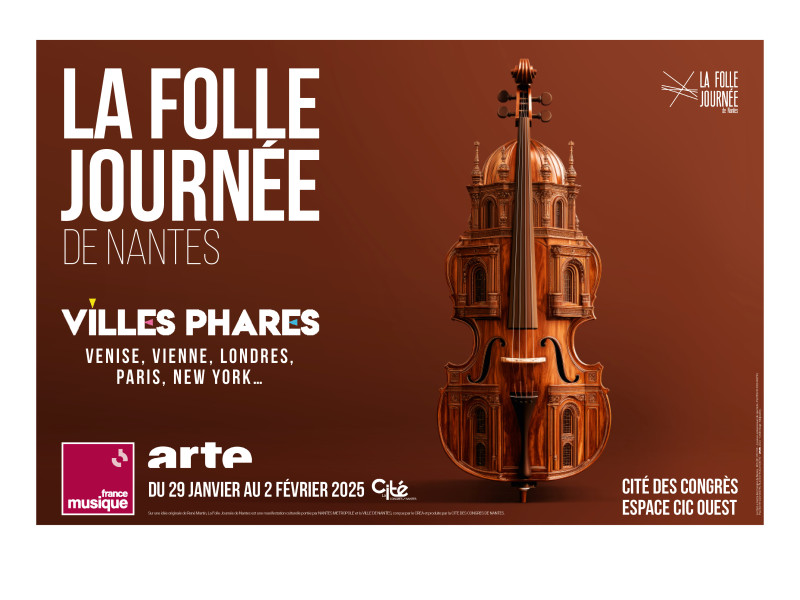 La folle Journée
2025
31e édition
La folle Journée
2025
31e édition
La Folle Journée 2025
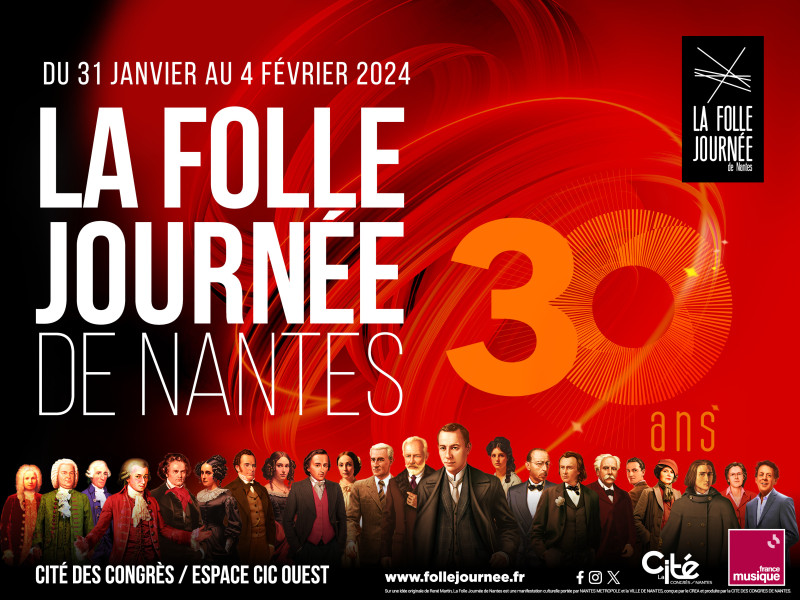 La folle Journée
2024
30e édition
La folle Journée
2024
30e édition
La Folle Journée 2024
En 2024, La Folle Journée fête ses 30 ans d'existence ! Pour cette édition exceptionnelle, nous revenons en quelque sorte aux origines de la musique, en mettant en lumière les traditions musicales qui ont nourri l'inspiration des compositeurs au fil des siècles et dans tous les pays du monde.
Ainsi Bach lui-même, justement surnommé le "père de la musique", n'en est pas moins issu d'une longue tradition musicale puisant ses racines dans la profondeur des temps et au creuset des civilisations. Et après lui tous les compositeurs, de quelques pays, de quelques continents qu'ils soient issus, se sont appuyés sur des héritages anciens pour forger leur langage et édifier leur œuvre.
Trois directions principales seront explorées pour évoquer ce thème très riche des origines :
- la question des origines en musique renvoie d'une part à l'émergence, à partir du milieu du XIX° siècle, des "écoles nationales" qui, aussi bien en Russie, Hongrie ou Tchécoslovaquie, qu'en Suède, Norvège, Danemark, France ou Espagne, se sont attachées à valoriser l'infinie richesse de traditions séculaires issues de l'âme des peuples - traditions qui se sont aussi nourries les unes des autres au fil des époques, dans un métissage fertile qui n'a cessé de féconder l'imagination des compositeurs.
La Folle Journée 2024 présentera ainsi nombre d'œuvres représentatives de ce grand courant musical qui a amené des compositeurs tels que Moussorgski, Tchaïkovski, Smetana, Dvorák, Kodály, Bartók, mais aussi Grieg, Sibelius, Albéniz, Granados, Ravel ou Bizet à puiser dans l'infinie richesse des traditions populaires de leurs pays respectifs.
- Le thème des origines en musique nous amène à nous intéresser également à l'évolution des formes musicales : comment sont nées ces grandes formes que sont la sonate, le quatuor, le concerto et d'autres, qui ont donné naissance à tant de chefs-d'œuvre d'une époque à l'autre ? C'est ce qu'illustreront lors de cette édition plusieurs programmes conçus spécialement pour l'occasion.
L'origine des instruments sera de même questionnée et mise en lumière : comment sont-ils apparus et quelle a été leur évolution au fil du temps ? À l'origine de toute musique était le souffle... Or, quel instrument mieux que la flûte - l'un des plus vieux instruments du monde, avec la harpe - incarne le souffle et donc l'origine du monde ? Des instruments très anciens seront également présentés parmi lesquels le oud, créé à Babylone il y a 2000 ans et symbole du monde arabo-persan, qui a traversé les siècles en s'adaptant à toutes les musiques, ou le duduk, instrument du chant de l'âme arménienne à la sonorité unique et envoûtante.
- Nous présenterons par ailleurs un certain nombre d'œuvres apparaissant comme des œuvres fondatrices en ce qu'elles ont ouvert, par leur caractère foncièrement novateur, des directions nouvelles, influençant de fait le cours de la musique : citons notamment Les Quatre Saisons de Vivaldi, Le Sacre du printemps de Stravinski, Pierrot lunaire de Schönberg ou West Side Story de Bernstein...
Texte : René Martin, Directeur Artistique
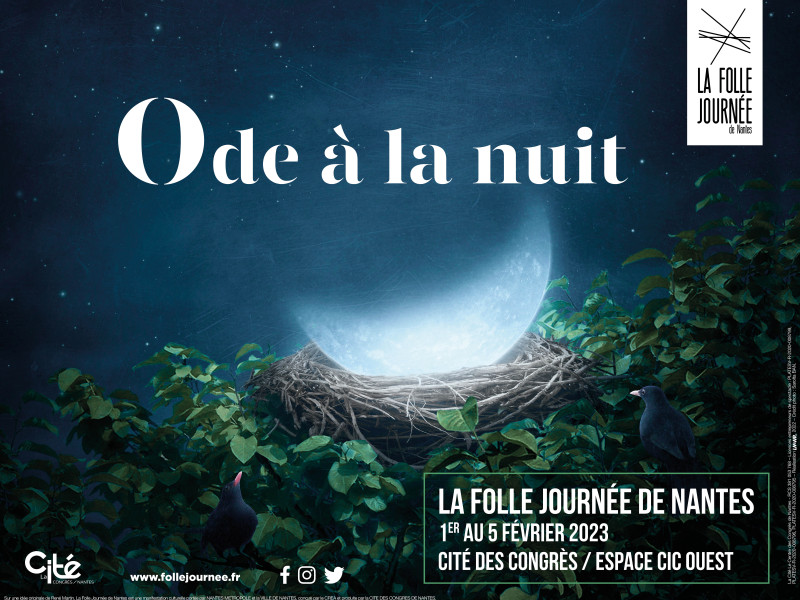 La folle Journée
2023
29e édition
La folle Journée
2023
29e édition
La Folle Journée 2023
ODE A LA NUIT
Source d'inspiration majeure dans toute l'histoire de l'art, la nuit a notamment beaucoup inspiré les musiciens : aussi loin que remonte l'origine du monde, ils ont chanté sa poésie et exploré tous ses aspects. Paisible ou tourmentée, sereine ou inquiétante, claire ou obscure, la nuit se décline en une infinie variété d'atmosphères que les compositeurs se sont de tous temps attachés à saisir et à recréer.
À l'époque baroque, ils méditent notamment sur la Passion du Christ à travers les “leçons de ténèbres” (de Couperin notamment) qui accompagnent les offices de la Semaine sainte, et dans un autre registre, se plaisent comme Lulli à illustrer la succession des heures du jour et de la nuit à travers des ballets grandioses. Au XVIIIe siècle s'épanouit le genre de la sérénade, musique de plein-air jouée à la tombée de la nuit dans les jardins, et dont l'exemple le plus célèbre est la Petite Musique de nuit de Mozart. La nuit fascine ensuite les compositeurs du XIXe siècle, qui en explorent toutes les facettes : propice aux visions angoissantes comme aux rêves enchanteurs - témoin le féérique Songe d'une nuit d'été de Mendelssohn -, la nuit est à cette époque évoquée à travers une forme, le nocturne, qui trouve son plein épanouissement avec Chopin ; la nuit se raconte aussi à travers le récit oriental des “mille et une nuits”, qui influence à cette époque de nombreux musiciens. Le XXe siècle se révèle également très riche en évocations de la poésie nocturne, avec des chefs-d'œuvre tels que La Nuit transfigurée de Schönberg, les Nocturnes pour orchestre de Debussy ou le Souvenir d'une nuit d'été à Madrid de Glinka...
Ce thème infiniment riche de la nuit en musique sera naturellement l'occasion pour la Folle Journée d'élargir son horizon en proposant beaucoup de programmes très originaux : concerts de jazz intitulés “Autour de minuit” en référence à la célèbre ballade de Thelonius Monk “Round Midnight”, concerts de musique indienne autour des râgas de nuit, spectacles de flamenco et de fado évocateurs des nuits de Séville ou de Lisbonne, concerts théâtralisés - autour des “leçons de ténèbres” et du rituel des bougies notamment -, et pour la première fois, concerts spécifiquement destinés aux bébés autour des berceuses, mais également, l'évocation de la nuit au cinéma avec des musiques de films emblématiques, comme celle de Georges Delerue pour La Nuit américaine de Truffaut, ou celle de John Williams pour Star Wars.
“Souvent il me semble que la nuit est bien plus vivante et richement colorée que le jour...”
Vincent Van Gogh
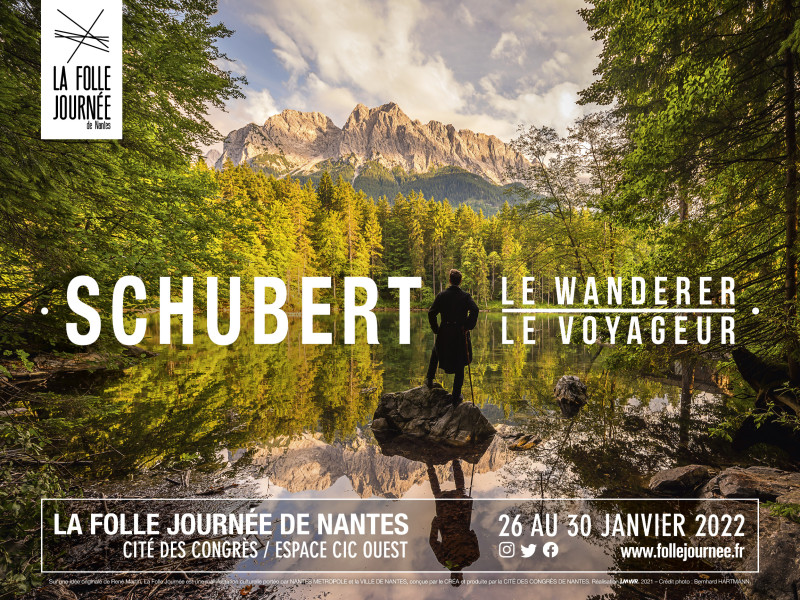 La folle Journée
2022
28e édition
La folle Journée
2022
28e édition
La Folle Journée 2022
Schubert, le voyageur
En 2022, La Folle Journée fut consacrée à “Schubert le voyageur”. Incarnation du “Wanderer”, figure emblématique du romantisme allemand, Schubert nous parle de voyage intérieur - celui de la quête de l'âme à travers les méandres de l'existence -, mais aussi de voyage en dehors de soi-même, pour prendre un nouveau départ, aller de l'avant, espérer à nouveau : Schubert est ainsi ce “marcheur” qui, inlassablement, reprend la route en quête de nouveaux horizons, de nouveaux espoirs. Le voyage en dehors de soi est aussi l'expérience de la rencontre des autres dans une quête de partage et d'enrichissement mutuel : Schubert est de ce point de vue le musicien de la communion fraternelle et de la convivialité heureuse, et le cœur battant des “Schubertiades”, rencontres musicales et lieu privilégié de l'échange et du dialogue amical. Symbolisant cet allant du voyageur libre de reprendre sa route, symbolisant aussi cet esprit de partage et de fraternité que nous aspirons tous à retrouver après l'épreuve, Schubert nous est ainsi apparu comme le plus à même de nous accompagner, pour cette nouvelle édition de La Folle Journée, sur le chemin de l'élan et de l'espoir retrouvés.
Texte : René Martin, Directeur Artistique
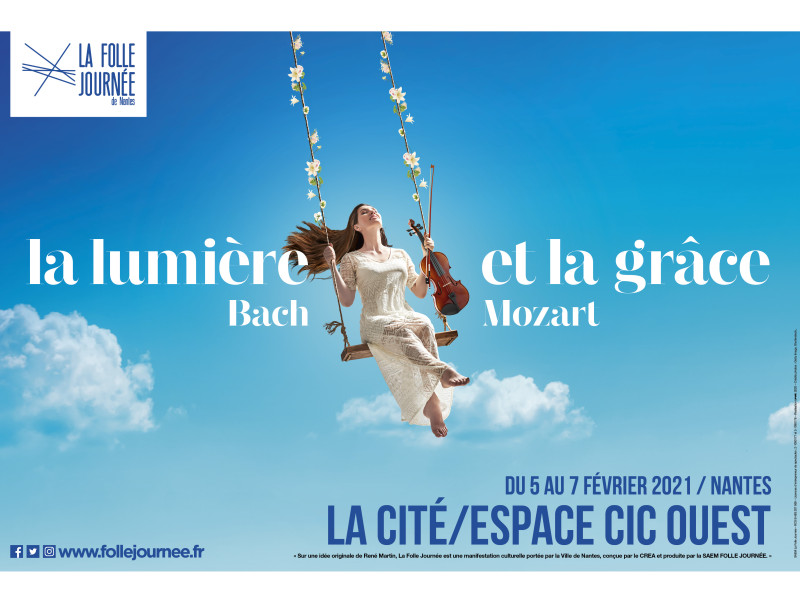 La folle Journée
2021
27e édition
La folle Journée
2021
27e édition
La Folle Journée 2021
“La lumière et la grâce : Bach et Mozart”
Véritables “piliers” de la musique occidentale, Bach et Mozart apparaissent l’un et l’autre, et plus que jamais à l’époque que nous vivons, comme des phares éclairant la route des hommes. Justement surnommé “le père de la musique”, Bach représente en effet le socle à partir duquel s’est construite la musique depuis trois siècles et son œuvre n’a, de fait, jamais cessé d’irriguer le cours de la musique occidentale, inspirant, de nos jours encore, des musiciens de tous horizons. Considéré comme le musicien le plus prodigieux de tous les temps, ayant porté à un degré de perfection jamais atteint le plus grand nombre de genres musicaux, Mozart fait de même figure de référence absolue rayonnant sur le panthéon de la musique.
Mais au-delà même de l’influence exercée par ces deux immenses créateurs sur le développement de leur art, c’est la puissance spirituelle qui se dégage de leur musique qui leur permet, encore aujourd’hui, de parler au cœur des hommes. Ainsi toute l’œuvre de Bach, comme sa vie, respire une force et une sérénité qui ne cessent de nourrir et d’éclairer ceux qui l’écoutent : aujourd’hui, encore et toujours, “Bach nous fait du bien” (Gilles Cantagrel) et il découle de sa musique un immense sentiment de plénitude. Miracle de grâce et d’équilibre, la musique de Mozart n’en est pas moins porteuse d’une émotion bouleversante, révélatrice de la profonde humanité du musicien ; sa vie exprime de fait la générosité de l’homme, sa bonté profonde et l’élévation de son esprit ; c’est pour cette raison aussi que sa musique n’a jamais cessé, depuis trois siècles, d’élever et d’apaiser l’âme des hommes.
Puissent ainsi la lumière de Bach et la grâce de Mozart éclairer cette nouvelle Folle Journée et nous permettre de nous retrouver, malgré les difficultés présentes, dans un grand élan de fraternité.
Texte : René Martin, directeur artistique
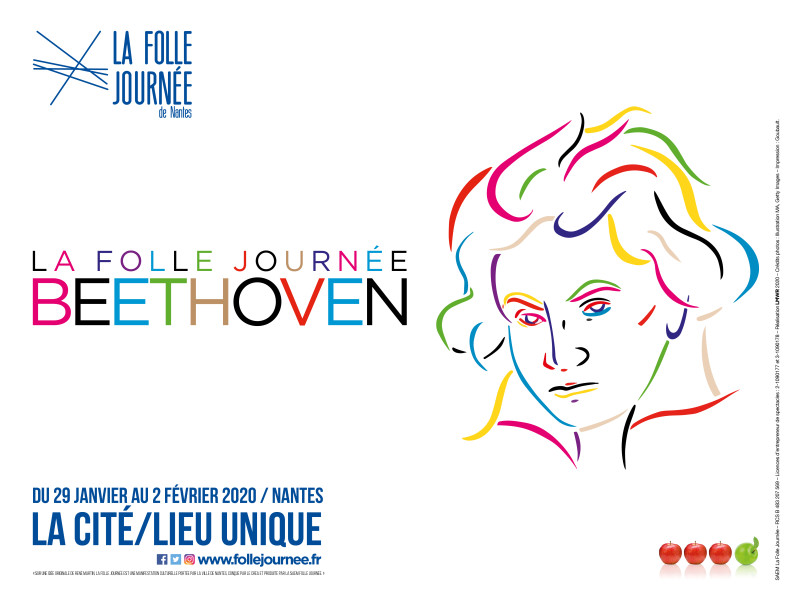 La folle Journée
2020
26e édition
La folle Journée
2020
26e édition
La Folle Journée 2020
BEETHOVEN
En 2020, le monde entier célèbrera le 250ème anniversaire de la naissance de Beethoven, l’un des plus grands génies de la civilisation occidentale. À la pointe de l’évènement, La Folle Journée donnera fin janvier le coup d’envoi des festivités, avec une programmation exceptionnelle qu’accueillera en tout premier lieu la Folle Journée de Nantes, et qui vous donnera à entendre tous les grands chefs-d’œuvre de Beethoven : l’intégrale des symphonies, l’intégrale des concertos pour piano, l’intégrale des trios avec piano, l’intégrale des quatuors à cordes et l’intégrale des sonates pour piano…. La Folle Journée sera en même temps, et comme chaque année, l’occasion de découvrir des œuvres inédites de Beethoven lui-même, et nombre d’œuvres inspirées de sa musique car beaucoup de compositeurs se sont aux XIXe et XXe siècles appropriés ses thèmes pour créer à leur tour des œuvres très originales, y compris dans le jazz et la musique électronique.
Unique dans l’histoire de la musique, l’œuvre de Beethoven l’est aussi par sa visée humaniste et par le message consolateur et fraternel qu’elle délivre toujours à tous les hommes. N'est-ce pas Beethoven lui-même qui définissait ainsi la finalité de sa musique : “Partie du cœur, qu'elle aille au cœur” ?"
Texte : René Martin, Directeur Artistique
 La folle Journée
2019
25e édition
La folle Journée
2019
25e édition
La Folle Journée 2019
Carnets de voyage
Après l’exil subi en 2018, place à l’exil choisi... La Folle Journée 2019 sera consacrée aux “Carnets de voyages” et à tous ces compositeurs qui ont créé des œuvres intemporelles à l’occasion de leurs voyages. À toutes les époques, les compositeurs en quête de nouveaux langages se sont aventurés sur des terres étrangères pour intégrer dans leur création nombre d’éléments puisés dans d’autres cultures. Mozart au XVIIIe siècle s’illustra par ses longs voyages à travers l’Europe, à Paris et Prague notamment, et Haydn à la fin de sa vie séjourna plusieurs années à Londres où furent créées ses dernières symphonies.
À l’époque romantique, Liszt apparaît comme le musicien voyageur par excellence ; véritable “citoyen du monde”, il parcourt notamment l’Italie qui lui inspire ses Années de pèlerinage et qui inspire à Berlioz, grand voyageur lui aussi, son célèbre poème symphonique Harold en Italie. Citoyen du monde, Mendelssohn l’était aussi, qui créa après ses nombreux séjours en Angleterre et en Italie, une symphonie “Ecossaise” et d’une symphonie “Italienne”. Dans le même temps, beaucoup de compositeurs italiens affluent vers Paris : Cherubini, Spontini, Rossini, qui bouleversent l’histoire de l’Opéra. Un peu plus tard, les musiciens russes avec Glinka, Tchaïkovsky, Rimski-Korsakov ou Glazounov se montrent particulièrement curieux de découvrir d’autres traditions musicales et effectuent de nombreux séjours en Espagne, en Italie et en France. À la même époque, Dvorak compose ses dernières grandes œuvres en découvrant le “Nouveau monde” cependant que le Norvégien Grieg achève son concerto pour piano lors d’un séjour au Danemark. Puis c’est Rachmaninov qui, au cours de ses premiers voyages outre-Atlantique, compose beaucoup de chefs-d’œuvre.
Dans l’univers des musiciens français, le voyageur infatigable qu’était Saint-Saëns se montre fascine par l’Orient ; puis c’est l’Espagne qui inspire à Ravel ou Chabrier quelques-unes de leurs plus belles pages (Rhapsodie espagnole, España...) cependant que de nombreux musiciens espagnols - Albéniz, Rodrigo, Granados... - choisissent de s’établir à Paris, alors capitale mondiale de la musique.
Un peu plus tard, Paris accueille également beaucoup de compositeurs américains Gershwin, Copland, Carter, Glass, Bernstein... -‘ notamment dans la classe prestigieuse de Nadia Boulanger. Et si Gershwin est l’auteur bien connu d’Un Américain à Paris, on sait aussi que Darius Milhaud composa son pendant français : A Frenchman in New York.
Plus près de nous, Olivier Messiaen compose en s’inspirant de ses voyages en Inde ou aux Etats-Unis (Des Canyons aux étoiles), et Jacques Ibert fait du voyage une composante essentielle de son œuvre avec des pièces telles que Escales ou la Symphonie marine. Trois compositeurs à cette époque – Jean Cras, Albert Rousse! et Rimski-Korsakov - étaient eux-mêmes marins et beaucoup de leurs œuvres ont été écrites lors de leurs voyages en mer.
À l’époque contemporaine, le voyage comme source d’inspiration première de la création musicale est aussi l’apanage de Jean-Louis Florentz, organiste français qui a effectué 25 voyages au cours de sa vie et a nourri son œuvre de ses longs périples au cœur de l’Afrique et du Proche-Orient. Beaucoup d’autres compositeurs contemporains ont livré de ces chefs-d’œuvre inspirés par la rencontre d’autres cultures citons notamment Edgar Varese, Tristan Murail ou les Japonais Toshio Hosokawa et Dai Fujikura.
Ce sont tous ces voyages effectués par les compositeurs au fil des époques qui vont nourrir la programmation de La 25e édition de La Folle Journée.
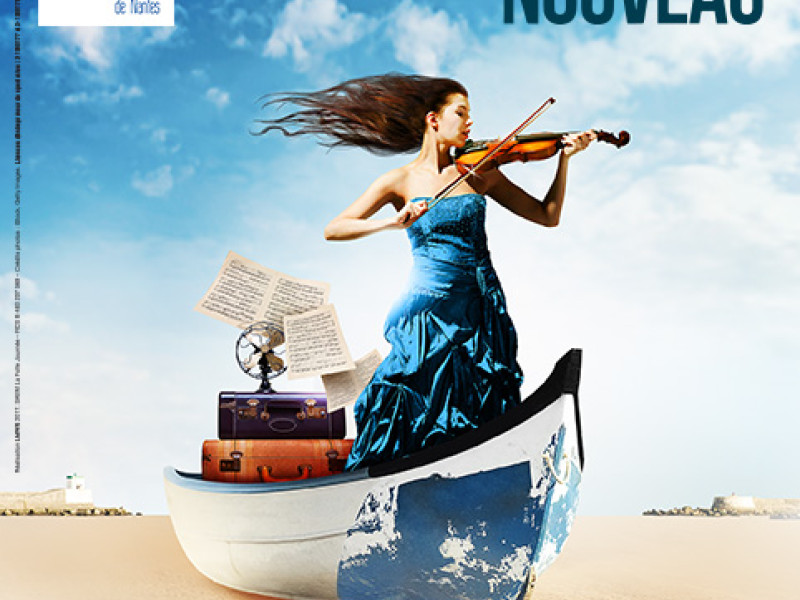 La folle Journée
2018
24e édition
La folle Journée
2018
24e édition
La Folle Journée 2018
Un Monde nouveau
"Un Monde nouveau" : nombreux sont, dans l'histoire de la musique, les compositeurs qui ont à un moment donné quitté leur pays, et parfois leur continent d'origine, pour s'établir dans une autre contrée ou y séjourner momentanément.
Ce sont en premier lieu des raisons politiques qui ont contraint, au XXe siècle essentiellement, de nombreux compositeurs à quitter leur patrie sous la pression de régimes totalitaires : fuyant la censure ou les persécutions, Rachmaninov, Prokofiev, Stravinsky, Bartók, Schoenberg, Granados, Albéniz et bien d'autres ont ainsi trouvé refuge dans des pays devenus d'importantes terres d'accueil pour les artistes exilés, parmi lesquels les États-Unis et la France avec Paris, capitale culturelle de l'époque.
L'histoire montre cependant qu'il est aussi des exils choisis, et non subis, par les compositeurs naturellement désireux de découvrir d'autres cultures, de s'approprier d'autres langages ; cette nécessaire ouverture au monde, condition de l'épanouissement du génie créateur, a ainsi conduit, à toutes les époques, de nombreux musiciens à s'aventurer sur des terres étrangères : ce sera notamment le cas de Dvořák, invité à la fin de sa vie à venir diriger le prestigieux Conservatoire de New York, où il séjournera trois ans en s'imprégnant de la culture populaire américaine.
Ce sont toutes ces oeuvres nées de la stimulante confrontation entre des univers différents que La Folle Journée s'attachera à mettre en lumière au cours de cette 24ème édition.
PRENEZ DATE : La Folle Journée 2019 se tiendra du 30 janvier au 3 février 2019
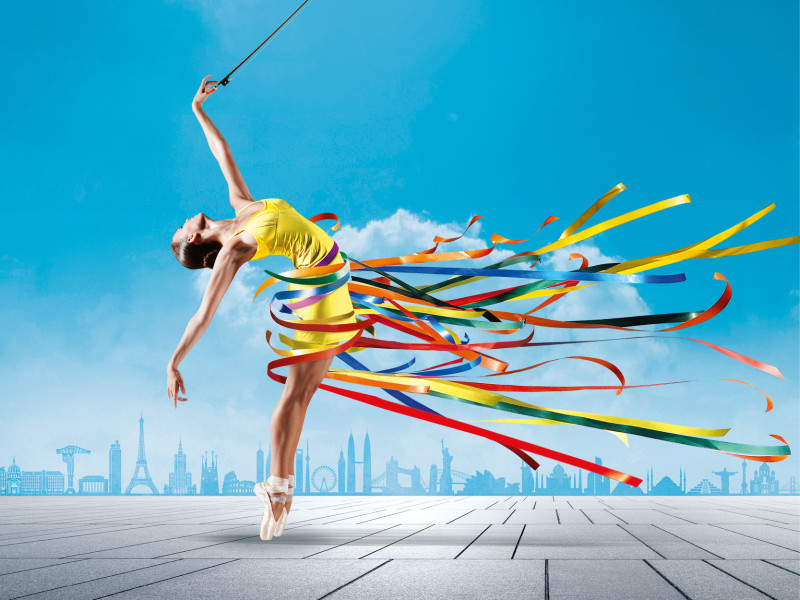 La folle Journée
2017
23e édition
La folle Journée
2017
23e édition
La Folle Journée 2017
LE RYTHME DES PEUPLES
Forme primitive de l'expression artistique, la danse est née du génie populaire.
Très tôt cependant, elle influence la musique savante : dès le Moyen-Âge en effet, elle s'invite dans les cours princières et suscite la création des premiers orchestres. Dès lors, les compositeurs composent toujours en référence à la danse, dont ils adaptent les rythmes à un style instrumental qui va naturellement en se complexifiant : ainsi les courantes, gigues ou sarabandes de Bach ou Rameau ne sont pas plus des musiques à danser que ne le seront plus tard, à l'époque classique et romantique, les menuets de Haydn, les ländler de Schubert ou les valses de Chopin.
Tout au long du XIXe siècle et au-delà, les compositeurs continuent d'utiliser de nombreux thèmes de danses, aussi bien dans la musique de chambre que dans la musique concertante ou symphonique. La tradition du ballet connaît par ailleurs son apogée avec les compositeurs russes - Tchaïkovsky, Borodine, Glazounov... jusqu'à Stravinsky qui ouvre la voie au modernisme avec son célèbre ballet Le Sacre du printemps, créé par Diaghilev en 1913. À la même époque en France, des musiciens tels que Bizet, Debussy, Ravel, Manuel de Falla ou Albéniz renouent avec des formes anciennes de danse - pavane, habanera, boléro... témoin l'exemple célèbre de Ravel -, et la danse reste tout au long du XXe siècle très présente dans l'inspiration des musiciens, comme le démontrent les collaborations scellées, au cours des dernières décennies, entre compositeurs et chorégraphes, comme par exemple entre John Cage et Merce Cunningham.
René Martin
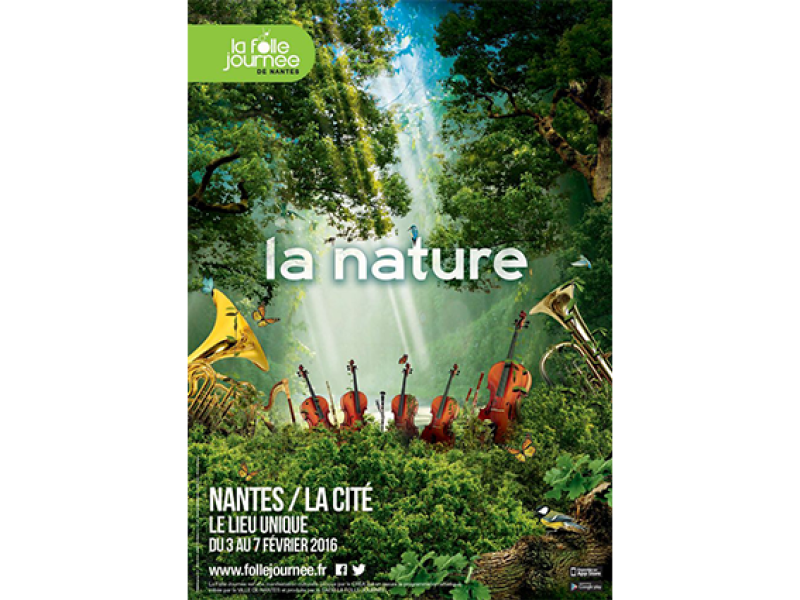 La folle Journée
2016
22e édition
La folle Journée
2016
22e édition
La Folle Journée 2016
LA NATURE
« La vraie musique est le langage du cœur. » Jean-Philippe Rameau
La 22ème édition de La Folle Journée a exploré durant 5 jours le thème universel de la Nature. Dès l’origine, fascinés par l’alternance des saisons, la diversité des paysages ou le déchaînement des éléments, les hommes se sont essayés à traduire en musique l’infinie palette de sensations que leur procurait le contact avec la nature. On peut ainsi dire que la musique est véritablement née de la nature. Celle-ci n’a cessé d’inspirer les musiciens à travers les âges.
Dès la Renaissance et durant l’ère baroque, des compositeurs comme Clément Janequin, Jean-Philippe Rameau et François Couperin se sont plu à imiter les bruits de la nature, comme le chant des oiseaux. Avec Vivaldi et ses Quatre Saisons, le regard sur la nature se fait plus contemplatif. Une longue tradition de musique pastorale se met en place avec les musiciens Carl Stamitz ou Justin Henri Knecht, qui ouvrent la voie à la fameuse Symphonie Pastorale de Beethoven. Propice au recueillement et à la méditation, la nature est devenue une confidente et joue un rôle essentiel chez les compositeurs romantiques qui puisent l’inspiration dans leurs promenades solitaires (Schubert, Schumann, Liszt et Brahms). Le thème a aussi fortement inspiré la création musicale des temps modernes : de Claude Debussy à Olivier Messiaen et Toru Takemitsu en passant par Maurice Ravel et Henri Dutilleux. Il continue aujourd’hui de procurer aux artistes une infinité de thèmes et d’émotions.
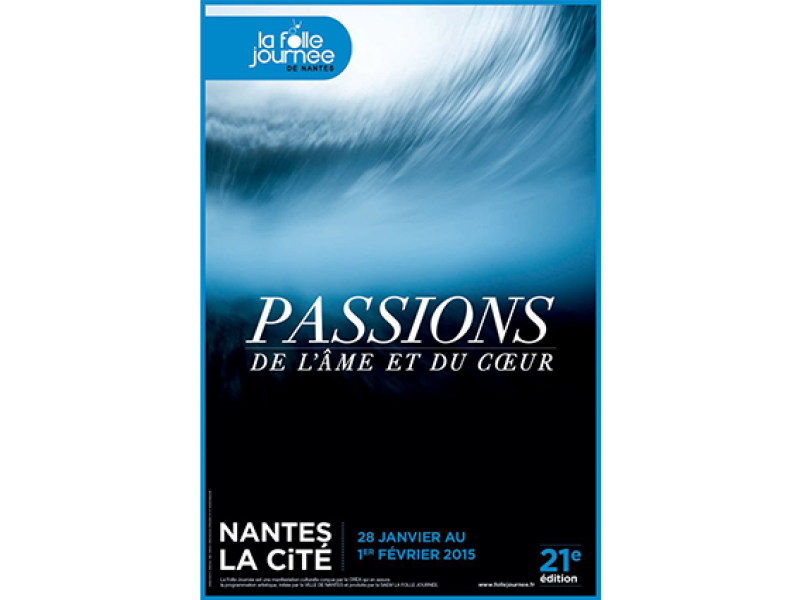 La folle Journée
2015
21e édition
La folle Journée
2015
21e édition
La Folle Journée 2015
PASSIONS DE L'ÂME ET DU COEUR
« Face à une œuvre d’art, on ne doit pas rêver, mais s’attacher à en percer la signification. » Arnold Schœnberg
Du 28 janvier au dimanche 1er février 2015, La Folle Journée a exploré le thème central de la sensibilité occidentale, plus précisément les passions de l’âme et du cœur, déclinées à travers un large répertoire profane et sacré, inspiré et saisissant. Les périodes représentées - des prémisses de l’époque baroque jusqu’au XXe siècle - ont invité les auditeurs à s’interroger sur les moyens que se donnaient les musiciens, de Monteverdi à Schœnberg, pour traduire l’inexprimable : la vie de l’âme humaine et ses mouvements.
La notion de « Passion » renvoie tout d’abord au récit des souffrances et de la mort du Christ mais elle met aussi en jeu, dans le domaine profane, les mouvements d’une âme en souffrance ou dans la joie. De grandes œuvres sacrées relatent la mort du Christ et la douleur des témoins de sa passion comme les passions de Schütz ou de Bach, le Membra Jesu Nostri de Buxtehude, Les Sept Paroles du Christ en Croix de Joseph Haydn ou encore les stabat mater de Scarlatti, Vivaldi et Pergolèse. Un riche corpus d’œuvres profanes, lyriques ou instrumentales explore la diversité des émotions humaines, comme Le Lamento d’Arianna de Monteverdi ou L’air de la Mort de Didon par Purcell. D’autres mouvements en rapport avec les sentiments ont été abordés au sein de cette édition : l’Empfindsamkeit (mouvement allemand datant du XVIIIe siècle), le romantisme, l’opéra et le drame lyrique. C’est cette véritable contagion émotive qu’a exploré la Folle Journée, en montrant combien l’expression de l’affect puis du sentiment, a toujours été l’une des gageures essentielles de l’acte créateur.
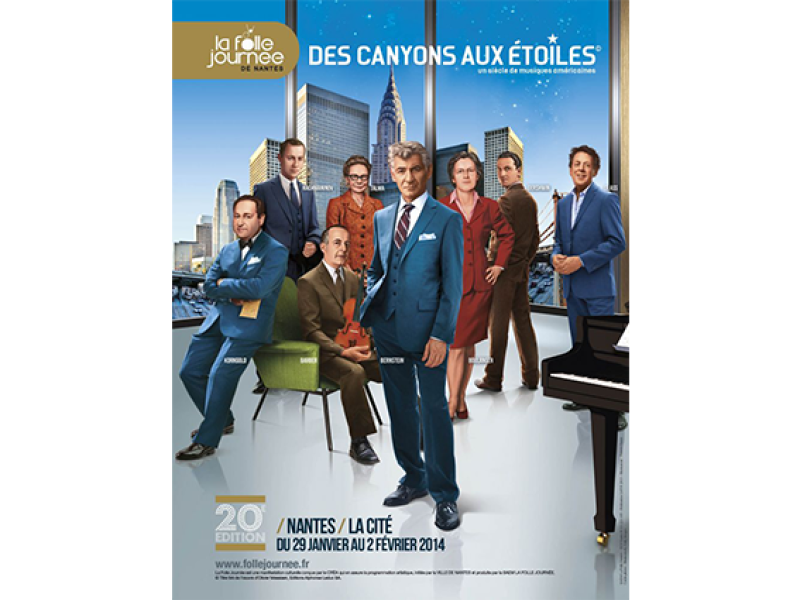 La folle Journée
2014
20e édition
La folle Journée
2014
20e édition
La Folle Journée 2014
DES CANYONS AUX ÉTOILES : LA MUSIQUE AMÉRICAINE DU 20ÈME SIÈCLE
« Une musique fascinante joue d’abord les mélodies à l’unisson, puis les décale lentement. » Steve Reich
Pour fêter ses 20 ans, La Folle Journée de 2014 a présenté un large panorama inédit et passionnant de la musique américaine des années 1860 à nos jours. Georges Gershwin, Leonard Bernstein, Steve Reich et Philip Glass illustraient cette édition.
Une partie du festival s’est consacrée à dévoiler quelques compositions nées aux États-Unis, terre d’accueil des plus grands compositeurs victimes des régimes totalitaires : Serge Rachmaninov, Igor Stravinsky, Arnold Schœnberg ou encore Béla Bartók. Le rôle essentiel des institutions américaines a également été souligné : de nombreux orchestres, fondations ou universités ont été commanditaires d’œuvres majeures du XXe siècle, comme celles de Luciano Berio, Olivier Messiæn ou Henri Dutilleux. Le cinéma a aussi été à l’honneur de cette édition avec la mise en avant de plusieurs artistes qui ont fait leur carrière à Hollywood : de Kurt Weill et Erich Wolfgang Korngold jusqu’à Bernard Hermann (Citizen Kane d’Orson Welles, Psychose d’Alfred Hitchcock), Hans Zimmer (Rain Man, Gladiator) ou encore John Williams (Star Wars).
Une grande place a été accordée à la musique populaire américaine avec la présence du jazz, du blues, du negro-spiritual et des comédies musicales de Broadway, de Show Boat (1927) à Hello Dolly (1964) en passant par Porgy and Bess (1935) et My Fair Lady (1956).
Une grande place a été accordée à la musique populaire américaine avec la présence du jazz, du blues, du negro-spiritual et des comédies musicales de Broadway, de Show Boat (1927) à Hello Dolly (1964) en passant par Porgy and Bess (1935) et My Fair Lady (1956).
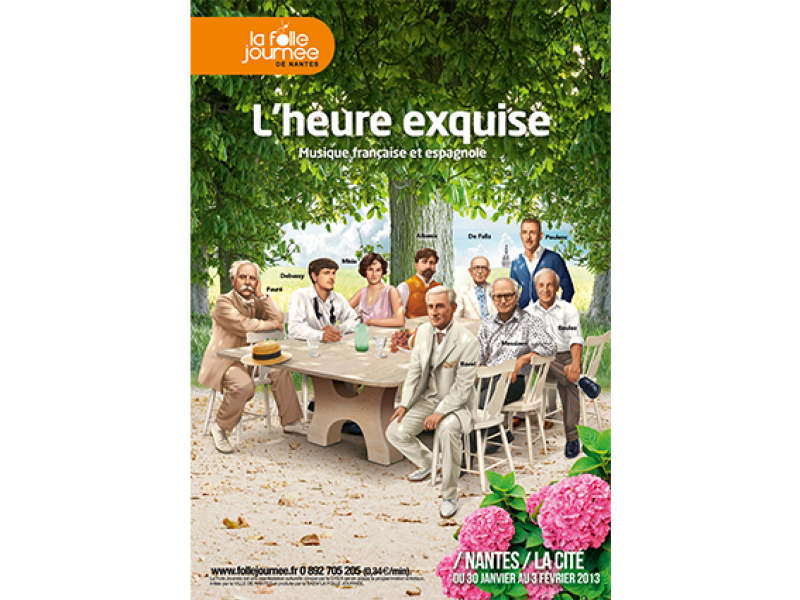 La folle Journée
2013
19e édition
La folle Journée
2013
19e édition
La Folle Journée 2013
L'HEURE EXQUISE
« Il faut avoir vis-à-vis de l’œuvre que l’on écoute, que l’on interprète ou que l’on compose, un respect profond devant l’existence même. Comme si c’était une question de vie ou de mort. » Pierre Boulez
Pour sa 19e année, La Folle Journée a choisi de retracer l’histoire de la musique française et espagnole de 1850 à nos jours, soit de Georges Bizet à Pierre Boulez (dont les œuvres ont été à l’honneur durant cette édition) et plus particulièrement l’âge d’or de la musique française : des années 1870 aux années 1940.
Tandis que s’éteignent les derniers feux du romantisme avec Alkan et à l’heure où Bizet révolutionne l’opéra français avec Carmen, des compositeurs tels que Camille Saint-Saëns, César Franck, Vincent d’Indy, Fauré, Duparc, Chausson mais aussi Albert Roussel et d’autres encore, sont à l’origine d’un véritable renouveau de la musique française tant dans le domaine de l’écriture orchestrale que dans celui de l’art vocal. Pensée en couleurs et en dissonances douces, épurant les mélodies et assouplissant les formes, cette musique subtile et raffinée ouvre la voix aux deux compositeurs les plus novateurs au tournant de ces deux siècles : Claude Debussy et Maurice Ravel. Émergeront plus tard de nouveaux mouvements et de nombreuses inspirations. Des compositeurs espagnols tels que Manuel De Falla, venu étudier à Paris, exerceront une influence profonde sur les musiciens français. Les années folles et le jazz bouleverseront ensuite le paysage musical français avec Erik Satie et les musiciens du fameux « Groupe des Six » et, pour terminer, l’éphémère groupe « Jeune France » témoignera la fin des années 1930.
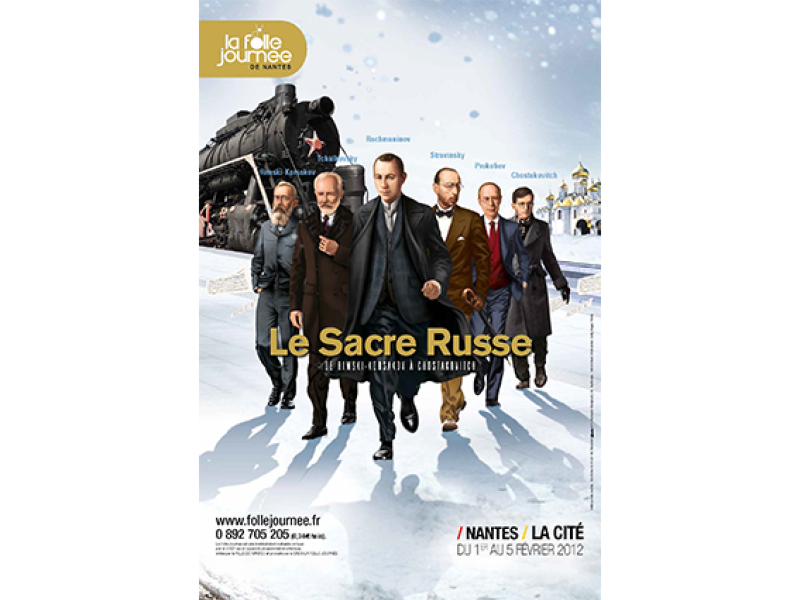 La folle Journée
2012
18e édition
La folle Journée
2012
18e édition
La Folle Journée 2012
LE SACRE RUSSE
« J’ai dit quelque part qu’il ne suffisait pas d’entendre la musique, mais qu’il fallait encore la voir. » Igor Stravinsky
La Folle Journée de 2012 a choisi, pour sa 18e édition, de se consacrer à la musique russe. Elle a donc mis en lumière le fameux « Groupe des Cinq » (Balakirev, Cui, Rimski-Korsakov, Borodine, Moussorgski) auquel on doit l’émergence d’une véritable musique nationale russe, ainsi que Tchaïkovski, considéré de son vivant comme le grand musicien national. Elle a également fait découvrir les œuvres de leurs successeurs : Liadov, Arensky et Glazounov, figures dominantes de la scène musicale russe au début du XXe siècle, à laquelle se rattache aussi Rachmaninov, dernier compositeur majeur de la grande tradition romantique russe.
L’édition représentera également l’œuvre de Scriabine qui apparaît au début du XXe siècle comme un pionnier du langage musical contemporain et dont les recherches seront poursuivies par les avant-gardistes Roslavetz, Lourié et Mossolov. Stravinsky, génie éclectique dont l’œuvre reflète les recherches et les paradoxes de son époque a lui aussi été au cœur de cette Folle Journée russe au même titre que Prokofiev, Chostakovitch et Weinberg. Des compositeurs tels que Glière, Katchaturian, Kabalevski, S. Goubaïdoulina, R. Chtchedrine, A. Schnittke ou A. Pärt ont complété ce vaste panorama et ont offert aux auditeurs l’occasion de retracer l’évolution de la musique russe de Glinka jusqu’à nos jours.
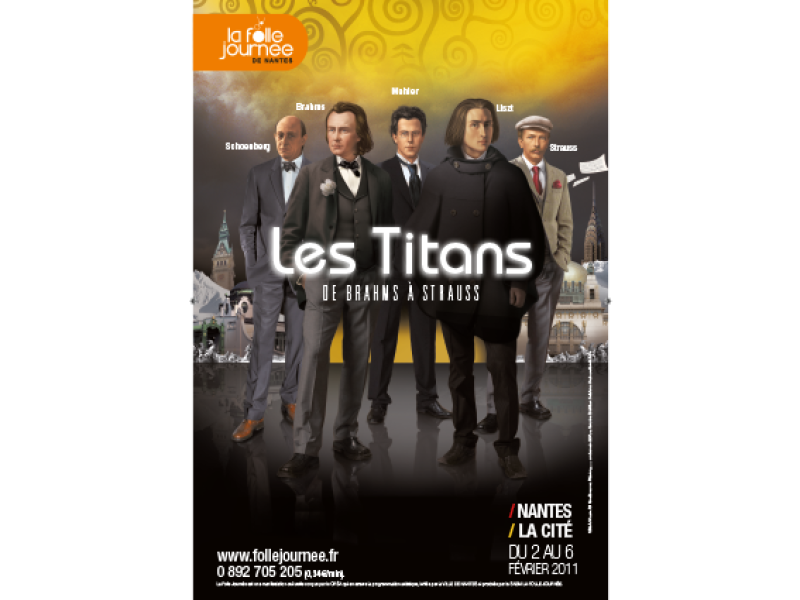 La folle Journée
2011
17e édition
La folle Journée
2011
17e édition
La Folle Journée 2011
LES TITANS : DE BRAHMS À STRAUSS
« La Deuxième Symphonie de Brahms est l’inquiète tendresse d’un regard face à la profondeur d’un monde psalmodié. »
Maxence Caron
La Folle Journée de 2011 s’est pleinement consacrée à la musique germanique post-romantique. Près de cent ans de musique ont été interprétés, de 1850 à 1950, soit de la période Brahms à Richard Strauss et aux compositeurs de l’école de Vienne.
Héritier de la grande tradition allemande et dernier grand musicien romantique, Brahms a exercé une influence considérable sur nombre de compositeurs de la seconde moitié du XIXe siècle : Max Bruch et Max Reger jusqu’à Arnold Schœnberg au début du XXe siècle. Dans la même période se développe sous l’impulsion de Wagner un puissant courant artistique visant à renouveler en profondeur le langage musical. S’y rattachent les autrichiens Bruckner (opposant de Brahms), Mahler, Hugo Wolf, Zemlinsky et l’allemand Richard Strauss dont la longue carrière s’étend de la fin de l’Empire austro-hongrois aux lendemains de la seconde guerre mondiale.
Brahms, Wagner, Mahler et Richard Strauss ont influencé l’école de Vienne. Celle-ci, en développant sa propre esthétique, influencera à son tour les compositeurs allemands Paul Hindemith, Carl Orff et Hanns Eisler.
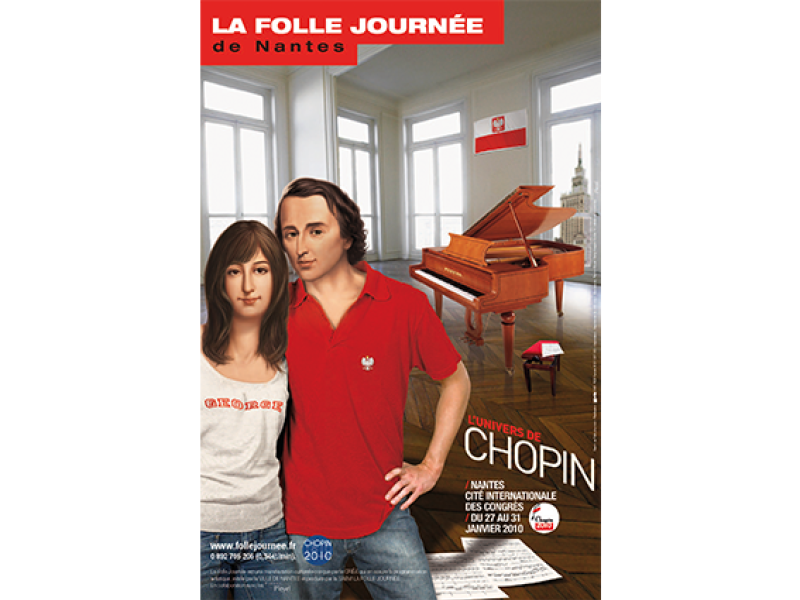 La folle Journée
2010
16e édition
La folle Journée
2010
16e édition
La Folle Journée 2010
« La simplicité est la réussite absolue. Après avoir joué une grande quantité de notes, toujours plus de notes, c’est la simplicité qui émerge comme une récompense venant couronner l’art. »
Frédéric Chopin
Abordant chaque année un compositeur majeur de l’histoire de la musique, La Folle Journée a choisi pour sa 16e édition de rendre hommage à l’une des figures les plus attachantes du romantisme musical : Frédéric Chopin. Dotée d’une grande variété d’émotions et de sentiments, le tout dans un langage accessible au plus grand nombre, l’œuvre de Chopin est aussi l’une des plus moderne qui soit, tant du point de vue de l’inspiration que sur le plan de l’écriture. Six pianistes de trois générations différentes ont donc porté leur regard sur Chopin durant cette Folle Journée : Anne Queffélec, Abdel Rahman El Bacha, Momo Kodama, Jean-Frédéric Neuburger, Philippe Giusiano et Iddo Bar-Shaï.
Rapidement intégré à l’élite parisienne, Chopin a mené une vie mondaine, ce qui lui a permis de côtoyer un grand nombre de virtuoses du piano mais aussi de faire la connaissance de ses amis Liszt, Mendelssohn et Berlioz - qui est le premier en France a avoir su discerner son immense talent. Chopin a également fréquenté des compositeurs et virtuoses moins connus : le violoncelliste Franchomme, les pianistes Czerny, Moscheles, Kalkbrenner, Herz, Alkan, Hiller mais aussi Clara Wieck, qui a été l’épouse de Schumann. Chopin admira également de grands noms comme Bach dont il jouait chaque matin les préludes et fugues, Hændel dont il admirait les oratorios, ainsi que Mozart.
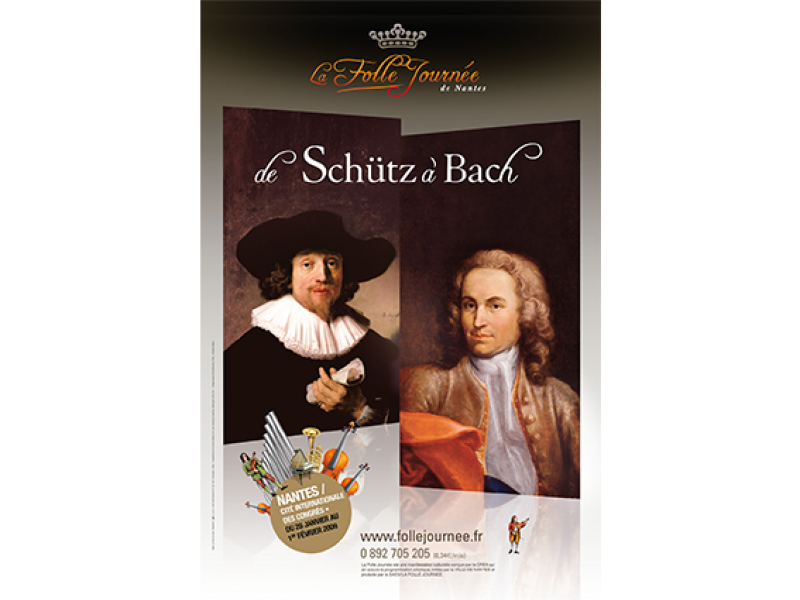 La folle Journée
2009
14e édition
La folle Journée
2009
14e édition
La Folle Journée 2009
DE SCHÜTZ À BACH
« Le but de la musique devrait n’être que la gloire de Dieu et le délassement des âmes. Si l’on ne tient pas compte de cela, il ne s’agit plus de musique mais de nasillements et beuglements diaboliques. » Jean Sébastien Bach
Cette 15ème édition de La Folle Journée a emprunté les chemins qui mènent jusqu’à Jean-Sébastien Bach. Elle s’est présentée donc comme la quatrième édition « baroque » après La Folle Journée de Bach en 2000, La Folle Journée « italienne » de 2003 et « L’Harmonie des Nations » en 2006. L’édition de 2009 a en effet fait découvrir des œuvres d’un certain nombre de compositeurs qui ont précédé Bach en Allemagne du Nord et qui constituent une part essentielle de l’héritage du grand musicien.
Jacob Praetorius, le grand Schütz et ses élèves (Matthias Weckmann, Christoph Bernhard, Johann Theile), Johann Adam Reincken, Buxtehude, Jacob Froberger apparaissent aujourd’hui comme les véritables fondateurs de la musique allemande. Leurs œuvres à l’immense richesse restent pourtant largement méconnues. Celles-ci ont donc été présentées au sein du festival, notamment une centaine d’œuvres de musique sacrée de Schütz parmi lesquelles l’intégrale des Psaumes de David, l’Histoire de la Résurrection et les Trois Passions qui figurent parmi les chefs-d’œuvre de la première époque baroque.
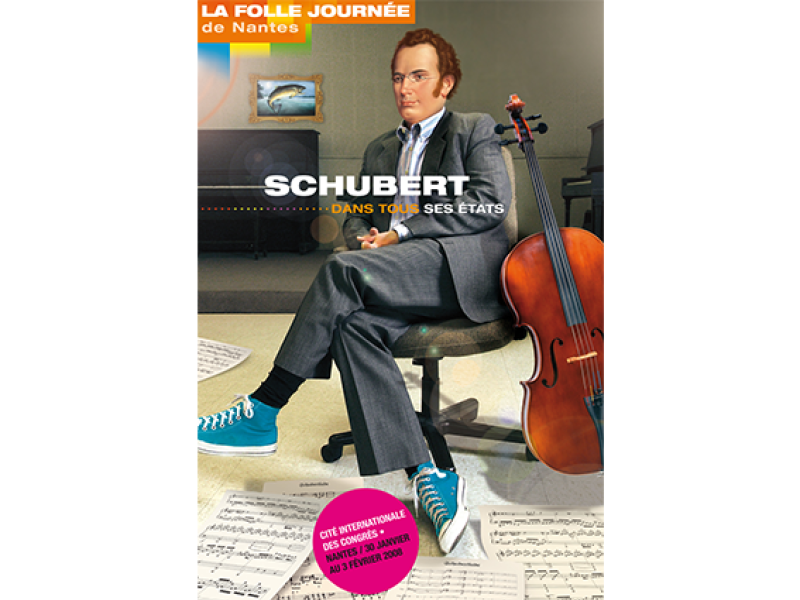 La folle Journée
2008
13e édition
La folle Journée
2008
13e édition
La Folle Journée 2008
« Jouis toujours du présent avec discernement, ainsi le passé te sera un beau souvenir et l’avenir ne sera pas un épouvantail. »
Franz Schubert
Pour cette 14e édition de La Folle Journée, trois compositeurs ont été invités à écrire une œuvre dans l’esprit de Schubert, grand compositeur viennois : les japonais Dai Fujikura, Toshio Hosokawa et le français Bruno Mantovani.
Au XVIIIe siècle, Vienne est la capitale européenne de la musique. La ville voit naître une succession de grands noms : Haydn, Mozart, Beethoven et Schubert. Parfait symbole du « voyageur » romantique (« Wanderer ») tant par sa vie que par son œuvre, Schubert est le dernier représentant d’un certain classicisme viennois. Novateur, admirateur de Beethoven et libre de toutes contraintes, ce génie créateur bouscule les formes musicales avec le lied par exemple, et devient l’égal des maîtres qu’il vénère (Gœthe, Schiller, Heine). L’artiste avait déjà écrit ses treize premiers quatuors et ses huit premières symphonies avant que la Neuvième Symphonie de Beethoven ne soit créée à Vienne en 1824. Il a également été l’inspirateur d’un groupe amical et culturel : les « Schubertiades ».
Malgré un plongeon dans l’oubli durant les dernières années de sa vie, Schubert est certainement l’un des compositeurs ayant le plus influencé les générations suivantes. On ne compte plus les transcriptions de ses œuvres qui ont été effectuées aux XIXe et XXe siècles. Ses créations continuent d’inspirer les compositeurs d’aujourd’hui.
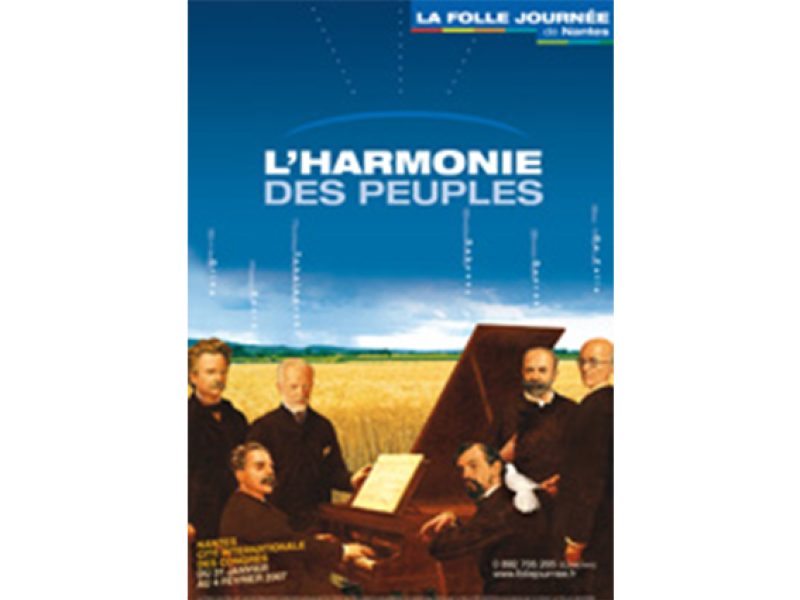 La folle Journée
2007
12e édition
La folle Journée
2007
12e édition
La Folle Journée 2007
L’HARMONIE DES PEUPLES
C’était au tour des XIXe et XXe siècles et de leurs prodigieux compositeurs d’être représentés par La Folle Journée de 2007. Avec une série de 278 concerts, le festival a voulu faire connaître le prodigieux épanouissement des écoles nationales qui ont agité le continent européen en 1848.
Forte de traditions populaires et historiques, la Russie de Glinka et de Tchaïkovski sera la première à s’élever au niveau des grandes nations musicales. Les écoles tchèque, hongroise, scandinave révèleront leur personnalité dans une musique savante alimentée aux sources des chants populaires au nationalisme intense. En Hongrie notamment, Bartók exprime son patriotisme en nourrissant son œuvre de timbres et de rythmes traditionnels. D’autres comme Berwald en Suède, Grieg en Norvège ou encore Nielsen au Danemark tirent leur inspiration des légendes, des trésors folkloriques et des paysages de leurs pays. L’Espagne affirmera à son tour une véritable conscience nationale alors que Paris deviendra le refuge de nombreux artistes espagnols attirés par la France : Albeniz, Granados, De Falla, Rodrigo. Les compositeurs français s’inspireront des œuvres de ces musiciens et puiseront dans l’étonnante richesse de la musique espagnole. Bizet, Fauré, Debussy, Ravel, Saint-Saëns ont ainsi recréé une Espagne imaginaire mais profondément authentique.
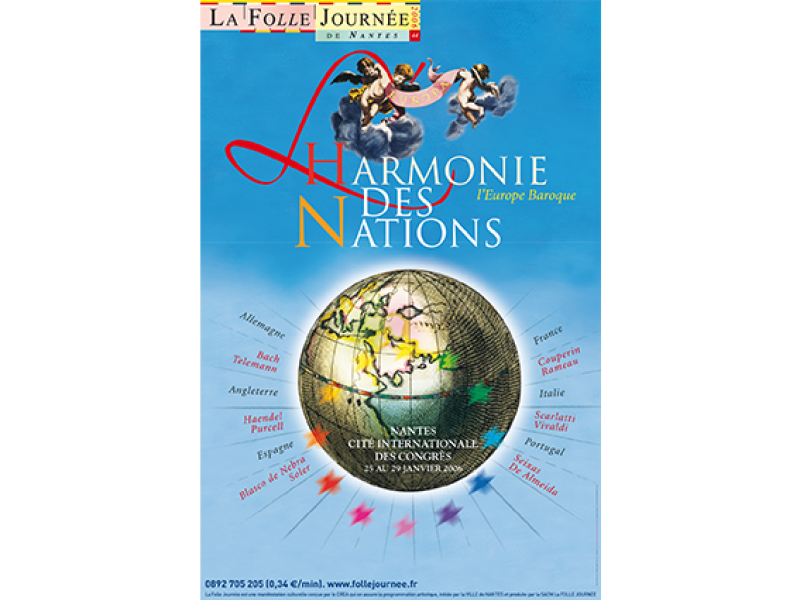 La folle Journée
2006
11e édition
La folle Journée
2006
11e édition
La Folle Journée 2006
L'HARMONIE DES NATIONS
La mélodie « n’imite pas seulement, elle parle » écrivait Rousseau, ce à quoi Rameau répondit : « C’est à l’harmonie seulement qu’il appartient de remuer les passions ».
Pour son édition de 2006, La Folle Journée de Nantes s’est passionnée à faire découvrir, à travers 265 concerts, les grands changements musicaux des XVIIe et XVIIIe siècles. Marquées par de nombreuses querelles esthétiques et de profondes mutations, les années 1650-1750 voient s’affirmer les écoles régionales autour de grandes nations qui, de l’Allemagne à la péninsule ibérique, de l’Italie à la France et à l’Angleterre, se partagent l’intérêt pour la musique. À cette époque où l’on assiste à une prise de conscience des styles nationaux, hommes et œuvres circulent à travers le continent. Des contacts étroits se nouent entre les compositeurs des provinces européennes : Rameau pour la France, Bach pour l’Allemagne, Purcell en Angleterre puis plus tard l’italien Scarlatti qui régna sur le clavecin à Lisbonne et à Madrid mais aussi le portugais Almeida qui étudia en Italie où Vivaldi faisait triompher le concerto.
Rameau, français d’origine gardera toujours un certain intérêt pour la musique ultramontaine, grâce à son voyage à Milan. Bach, lui, ne quittera jamais son pays natal mais il aura su s’imprégner de la musique française et des concertos de Vivaldi pour les intégrer à la musique luthérienne. En Angleterre, Purcell a su s’inspirer des styles italiens et français tout en restant britannique. En ce qui concerne l’oratorio anglais, on le doit à Hændel, pourtant imprégné d’art italien.
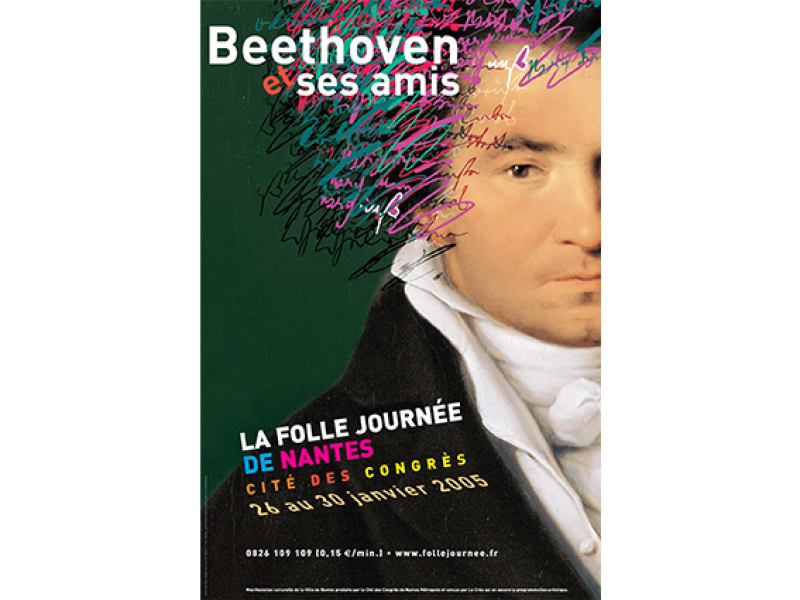 La folle Journée
2005
10e édition
La folle Journée
2005
10e édition
La Folle Journée 2005
BEETHOVEN ET SES AMIS
« Si tu veux être international, chante ton pays. » Ludwig van Beethoven
Comme en 1996, La Folle Journée a consacré son édition de 2005 au célèbre compositeur Ludwig van Beethoven. Considéré comme l’un des plus grands et influents créateurs de notre civilisation, il est aussi le premier compositeur indépendant de l’histoire de la musique. Animé de nobles idéaux artistiques à visée humaniste, ce génie révolutionnaire a sonné le glas du classicisme viennois et ouvert la voie au romantisme allemand. Il avait en lui la certitude que la musique devait contribuer au progrès de l’humanité en la guidant de l’ignorance vers la lumière.
Beethoven avait beaucoup d’amis, qui ont été aussi représentés au sein de cette édition. La plupart de ses rencontres ont eu lieu à Vienne dans le monde de la musique. Quand il s’y est installé en 1792, cette capitale culturelle d’exception était le passage obligé des musiciens en tournée en Europe. En 1800, la renommée du compositeur lui vaut d’être apprécié par de nombreux autres artistes. En dehors de ses amis Weber et Clementi qui jouissent encore d’une grande réputation, les autres sont très peu connus aujourd’hui. Parfois musiciens virtuoses, ce sont aussi des compositeurs prolifiques, des éditeurs, des auteurs et des témoins directs de la vie de l’immense compositeur. Aujourd’hui, il est possible de connaître des détails fascinants sur la vie de Beethoven, notamment à travers des œuvres biographiques rédigées avec soin par certains de ses proches, tels que Ries et Moschelès.
 La folle Journée
2004
9e édition
La folle Journée
2004
9e édition
La Folle Journée 2004
LA GÉNÉRATION 1810 : CHOPIN, SCHUMANN, LISZT, MENDELSSOHN
« La musique est ce qui nous permet de nous entretenir avec l’au-delà. »
Robert Schumann
Pour sa 10ème édition, La Folle Journée a réuni quatre des plus grands musiciens du XIXe siècle : Mendelssohn, Schumann, Chopin et Liszt, tous nés en l’espace de trois ans. Ces compositeurs s’affirment par leur personnalité, leur aisance technique, leur raffinement mais aussi par le caractère de leurs œuvres : Mendelssohn le brillant et le cultivé, Chopin l’exigeant, Schumann le torturé et Liszt le grand voyageur. Mais on retrouve une aspiration commune aux compositeurs de la « génération 1810 » : doués pour la musique dès l’enfance, ils ont tous puisé leur inspiration aux mêmes sources, ayant eu une immense admiration pour les compositeurs classiques tels que Hændel, Bach, Mozart, Haydn et Beethoven.
Les quatre artistes sont tous des musiciens complets qui sont à la fois pianistes virtuoses, compositeurs et critiques musicaux. Chez eux (peut-être moins chez Chopin), on retrouve cette recherche dans l’écriture, cette dimension visionnaire, cet esprit critique contradictoire et torturé qui s’exprime souvent à travers des inspirations oniriques ou mythologiques dans lesquelles puisent également des écrivains contemporains comme Gautier ou Musset. Au-delà de la musique, l’amitié était ce qui liait davantage les artistes : Schumann admirait profondément la musique de Chopin, et a été très affecté par le décès de son ami fidèle Mendelssohn. Chopin, lui, a été présenté à George Sand par Liszt, qui lui-même a rencontré sa future épouse chez Chopin…
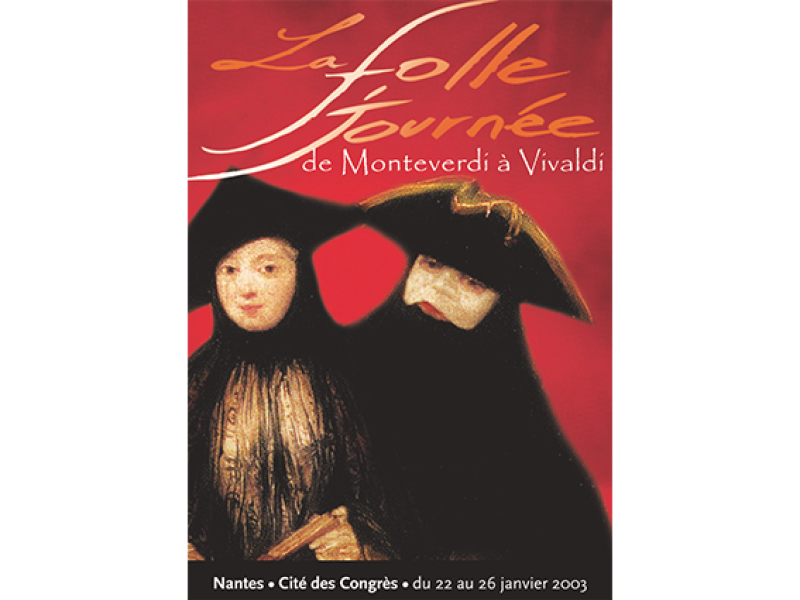 La folle Journée
2003
9e édition
La folle Journée
2003
9e édition
La Folle Journée 2003
MUSIQUE ITALIENNE DE MONTEVERDI À VIVALDI
« La musique est la langue des émotions. » Emmanuel Kant
La musique italienne est un terrain de transformation entre tradition et modernité. La Folle Journée a proposé pour son édition de 2003 un parcours musical flamboyant dans l’Italie baroque des XVIe et XVIIe siècles. Du baroque aux prémices du classicisme, les compositeurs Gabrieli, Palestrina, Gesualdo, Monteverdi, Scarlatti, Vivaldi, Pergolese et Clementi ont été les piliers des triomphantes écoles italiennes.
Au XVe siècle, une pléiade musicale réunit l’école franco-flamande et l’école italienne. Le rayonnement et le rapprochement entre ces deux centres musicaux européens représentent l’événement du Cinquecento. Vers la fin du XVe siècle, ce sont deux villes et deux cours princières qui jouent un rôle déterminant dans le réveil de la musique italienne : Florence et Mantoue. Viennent au XVIe et XVIIe siècles Rome et Venise, deux villes-muses, inspiratrices de nombreux compositeurs qui dominent la créativité artistique et les renouvellements dans le domaine musical. Rome, par la présence du Pape, favorise l’essor de la musique sacrée et Venise développe le style polyphonique vocal et instrumental. L’école napolitaine fut également importante. Foyer des Scarlatti, ce centre musical donna naissance à l’opéra lyrique et dramatique dit « opera seria ». On peut donc parler de l’Italie comme d’un kaléidoscope musical dont les œuvres sont indissociables des courants de pensée littéraires, philosophiques et religieux.
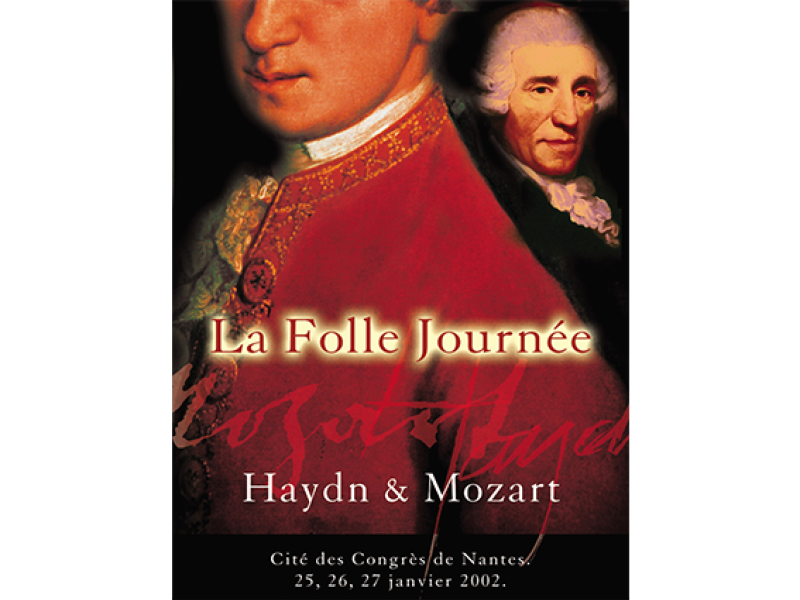 La folle Journée
2002
8e édition
La folle Journée
2002
8e édition
La Folle Journée 2002
MOZART - HAYDN
« Si je pouvais imprimer dans l’âme de chaque amateur de musique, et principalement dans celle des grands de ce monde, ce que je ressens devant les inimitables travaux de Mozart, les nations rivaliseraient pour posséder un tel joyau dans leurs murs. » Joseph Haydn
Pour sa 8e édition, La Folle Journée a réuni les deux maîtres absolus de la musique classique : Joseph Haydn (1732-1809) et Wolfgang Amadeus Mozart (1756-1791). Elle présenta en trois jours (les 25, 26 et 27 janvier) les œuvres maîtresses des deux compositeurs et notamment des compositions exceptionnelles qu’il est rare de découvrir en concert : les grandes messes et les oratorios (Nelsonmesse, Theresienmesse, Pauken-messe, La Création de Haydn, Requiem, Messe en ut mineur de Mozart, etc.). Les œuvres de musique de chambre ont été également mises à l’honneur à côté des grandes symphonies, des concertos ou encore des quatuors à cordes.
Les deux musiciens, qui ont entretenu des relations amicales, connurent cependant des destins différents. Haydn vivait au service des princes Esterházy et ne quitta son pays natal qu’à l’âge de 58 ans, tandis que Mozart était dès son plus jeune âge présenté à l’Europe entière pour son génie précoce. Haydn et Mozart ont retranscrit à la perfection le langage musical de leur époque, fait de délicatesse, d’équilibre, d’une finesse de discours et d’une émotion bouleversante.
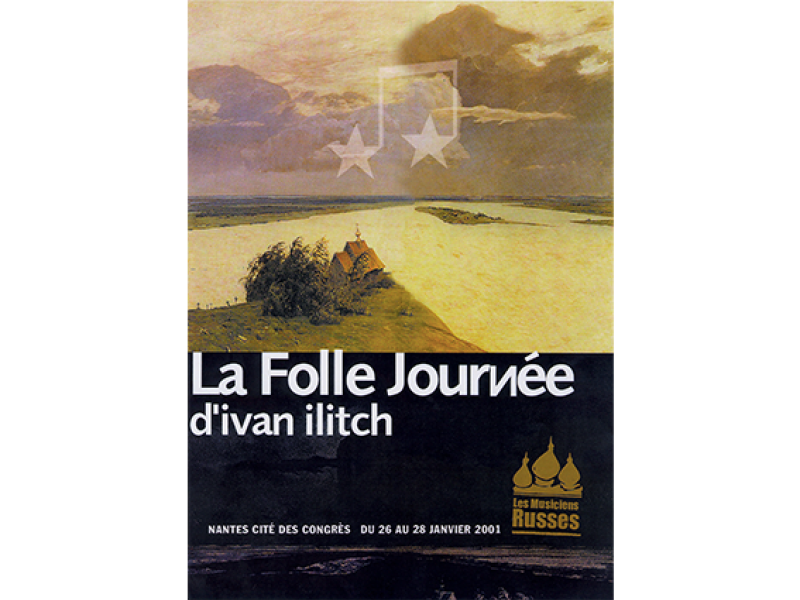 La folle Journée
2001
7e édition
La folle Journée
2001
7e édition
La Folle Journée 2001
IVAN IIITCH
« La musique est une révélation. » Piotr Tchaïkovski
En 2001, La Folle Journée s’est offert un parcours géographique et historique en traversant la Russie, de Moscou et Saint-Pétersbourg aux contrées aujourd’hui indépendantes, et du milieu du XIXe siècle à nos jours. Cette 7e édition s’est révélée à travers l’envie de faire découvrir des compositeurs phares qui ont marqué l’histoire de la musique par leurs chefs-d’œuvre. L’idée était également de faire découvrir l’âme russe des artistes, dotée d’une grande force sentimentale.
Ces trois jours ont permis de présenter une grande partie de la musique de chambre ainsi que d’un éventail d’œuvres chorales, instrumentales et orchestrales de divers compositeurs tels que Tchaïkovski, Moussorgski, Glazounov, Glinka, Borodine, Scriabine, Rimski-Korsakov, Rachmaninov, Prokofiev, Stravinsky et Chostakovitch. Autour d’eux étaient présents une multitude d’autres compositeurs moins connus mais tout aussi surprenants à découvrir : Arensky, Lourié, Taneïev, Gretchaninov, Sviridov, Goubaïdoulina et Schnittke.
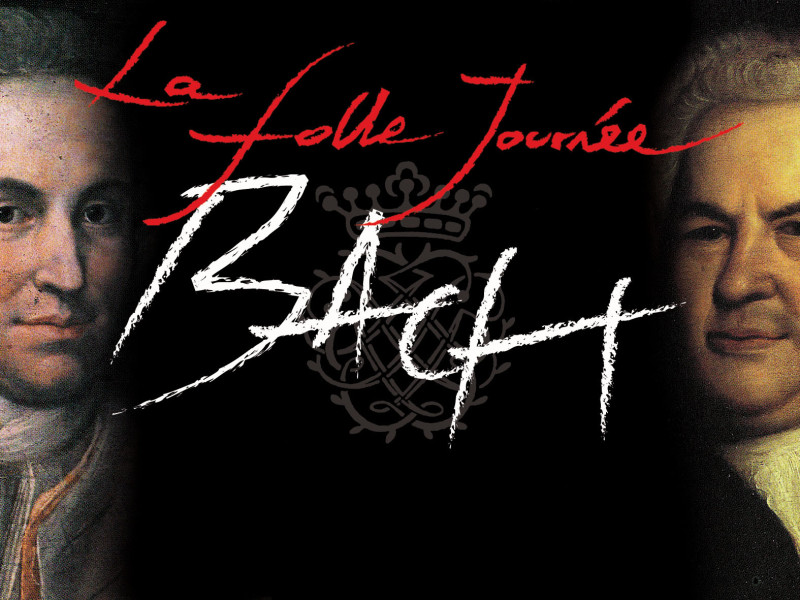 La folle Journée
2000
6e édition
La folle Journée
2000
6e édition
La Folle Journée 2000
BACH
« J’ai beaucoup travaillé. Quiconque travaillera comme moi pourra faire ce que j’ai fait. » Jean-Sébastien Bach
Pour démarrer l’an 2000 et commémorer les 250 ans de la mort de Jean-Sébastien Bach, cantor de Leipzig, la 6e édition de La Folle Journée a consacré trois jours à la quasi-totalité de son œuvre pour instruments solistes, à sa musique de chambre, à ses concertos brandebourgeois, à ses grandes œuvres chorales (passions, Messe en si, Magnificat) ainsi qu’à une partie de son catalogue pour orgue (un instrument avait été installé à l’occasion dans le grand auditorium de la Cité des Congrès).
Jean-Sébastien Bach (1685-1750) est un compositeur et organiste d’origine allemande dont l’œuvre fait partie des monuments de la musique classique. Issu d’une famille de musiciens, Bach se retrouve vite orphelin mais est élevé par son frère, musicien organiste. Il reçoit donc une solide formation en chant, en violon et en orgue mais c’est en étudiant durement qu’il assimile l’art de la composition. Insensible aux humeurs de son temps, la musique de Bach est, depuis plus de trois siècles, porteuse d’une émotion intacte. Elle traverse l’histoire et les hommes avec la même fraîcheur. L’héritage musical du compositeur sera maintenu pendant une génération par ses fils avant d’être remis au goût du jour par les romantiques. Sa musique bénéficie aujourd’hui de l’exécution passionnée et exigeante des interprètes les plus investis de notre siècle.
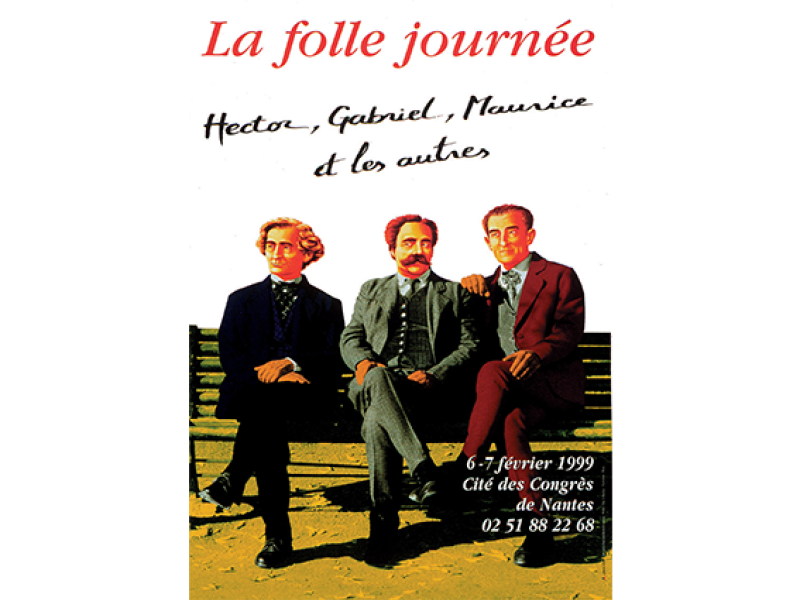 La folle Journée
1999
5e édition
La folle Journée
1999
5e édition
La Folle Journée 1999
HECTOR, GABRIEL, MAURICE ET LES AUTRES
« La chance d’avoir du talent ne suffit pas ; il faut encore le talent d’avoir de la chance. » Hector Berlioz
En 1999, après quatre années révélant des compositeurs aux penchants plutôt romantiques, La Folle Journée s’est ouverte vers de nouveaux horizons en déclinant un siècle de musique française autour d’Hector Berlioz, Gabriel Fauré et de Maurice Ravel, grands compositeurs qui ont principalement marqué le XIXe siècle. Cette 5e édition qui s’est déroulée les 6 et 7 février a prouvé sa variété et son originalité : de 1830 (création de la Symphonie Fantastique) à la seconde guerre mondiale, elle a fait revivre les musiciens qui ont marqué leur temps.
Ces deux jours au sein de la Cité des Congrès de Nantes ont permis de présenter quasi intégralement la musique de chambre de Berlioz, Ravel, Fauré, Saint-Saëns, Franck, Debussy, ainsi qu’un large éventail de leurs œuvres chorales, instrumentales et orchestrales. Autour d’eux, une multitude d’ « autres » compositeurs étaient également représentés : Kœchlin, Roussel, Offenbach, Magnard, Lalo, Satie, Dukas, Duparc, Chabrier, Caplet, Bizet…, sans oublier certains compositeurs restés dans l’ombre tels que Ladmirault, Pierné, Schmitt, Cras, Séverac ou encore Lekeu.
 La folle Journée
1998
4e édition
La folle Journée
1998
4e édition
La Folle Journée 1998
BRAHMS
« Sans la maîtrise du métier, l’inspiration est un simple roseau agité par le vent. » Johannes Brahms
Du 31 janvier au 1er février 1998, le compositeur, pianiste et chef d’orchestre allemand Johannes Brahms était au cœur de l’attention du festival La Folle Journée.
Né en 1833 à Hambourg et mort en 1897 à Vienne, Brahms est considéré comme l’un des plus importants musiciens de la période romantique et comme le « successeur » de Ludwig van Beethoven. Plus précisément, il se situait à la charnière entre le classicisme et le romantisme. Ce compositeur pour piano, musique de chambre, orchestre symphonique et pour voix et chœurs a passé une grande partie de sa carrière à Vienne. C’est son père, contrebassiste, qui lui donna ses premières leçons musicales. Il travaillera plus tard avec le célèbre pédagogue Eduard Marxsen qui lui fera découvrir les œuvres de Jean-Sébastien Bach.
Les œuvres de Brahms couvrent tous les genres hormis l’opéra. Durant ses premières expériences professionnelles, il acquiert une solide connaissance de l’écriture chorale et chambriste. À la fois traditionaliste et novateur, sa musique utilise des structures et des techniques de composition des maîtres baroques et classiques. La vie de Brahms a été marquée par des rencontres avec les musiciens Antonin Dvorak, Wagner, Schumann, Joseph Joachim avec qui il noua de grandes amitiés. Sa musique, critiquée par beaucoup de contemporains comme « trop académique » a été admirée par la suite par des personnalités comme Arnold Schœnberg ou Edward Elgar.
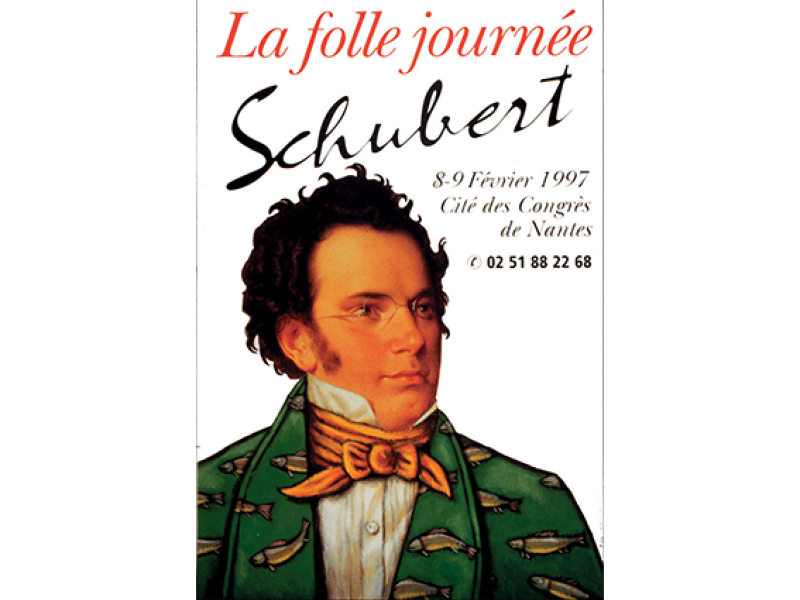 La folle Journée
1997
3e édition
La folle Journée
1997
3e édition
La Folle Journée 1997
SCHUBERT
« Jouis toujours du présent avec discernement, ainsi le passé te sera un beau souvenir et l’avenir ne sera pas un épouvantail. » Franz Schubert
L’année 1997 représenta le bicentenaire de la naissance de Franz Schubert. Nantes et le festival de La Folle Journée fêtaient donc cet anniversaire avec cette 3e édition consacrée à cet homme venu au monde pour composer.
Né en 1797 à Vienne, Schubert est un compositeur considéré comme « le classique du romantisme ». Formé au violon par son père, et au piano par son frère, il a également eu un riche apprentissage (chant, alto, orgue, contrepoint, harmonie) avec son professeur Michael Holzer. Il reçoit également des leçons de Salieri, tout en étant violoniste dans un orchestre du collège municipal Stadtkonvikt. Après avoir travaillé quelques années dans l’école que son père dirigeait, il décida de se consacrer pleinement à son don : la musique.
En se consacrant entièrement à la composition, Schubert est devenu le père du lied romantique allemand avec son premier chef-d’œuvre Marguerite au rouet D118 créé en 1814. Pour ce qui est de la composition de ses 600 lieder, Goethe, Rückert, Shakespeare et Wilhelm Müller étaient ses poètes de prédilection. Admiré par une certaine élite et habitué des soirées musicales privées appelées les « Schubertiades », Schubert ne donna son unique concert public à Vienne que quelques mois avant sa mort.
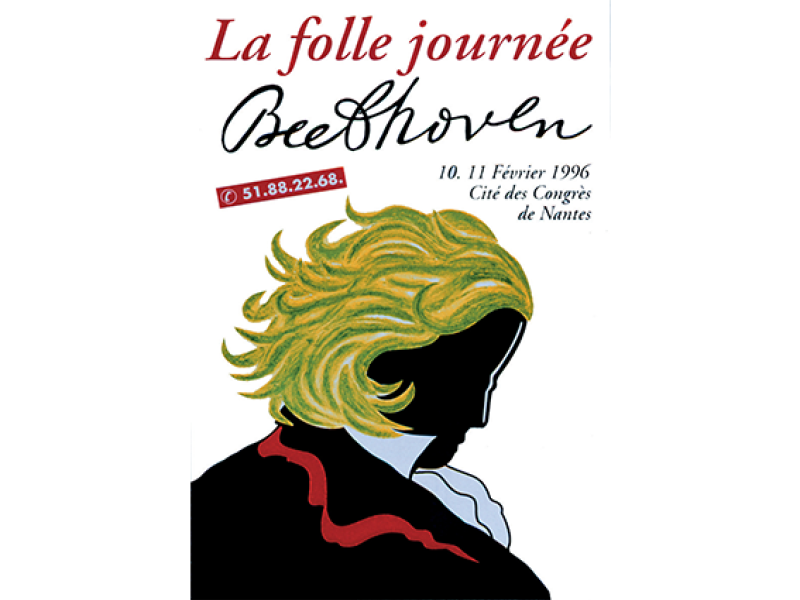 La folle Journée
1996
2e édition
La folle Journée
1996
2e édition
La Folle Journée 1996
BEETHOVEN
« La musique est une révélation plus haute que toute sagesse et toute philosophie » Ludwig van Beethoven
Les 10 et 11 février 1996, La Folle Journée célébra le grand compositeur Beethoven avec une série de concerts, expositions, conférences, vidéos, films…
Compositeur et pianiste allemand, Beethoven est né en 1770 à Bonn, en Allemagne. Ce grand représentant du classicisme viennois a été inspiré par la voie du romantisme et a influencé la musique occidentale pendant une grande partie du XIXe siècle. Son art s’est exprimé à travers plusieurs genres musicaux et bien que sa musique symphonique dont la 9e Symphonie que l’on retient particulièrement, soit la principale source de son génie et de sa réputation, il a également eu un fort impact dans l’écriture pianistique et dans la musique de chambre.
Trois genres musicaux constituent l'empreinte de Beethoven : la symphonie, le quatuor et la sonate. Le compositeur a su faire sortir sa musique du cadre classique en la faisant évoluer vers une tout autre forme favorisant l’expression des sentiments. Sa créativité se révèle dans un contexte d’une Europe en pleine mutation sociale et politique donnant naissance à la démocratie. Beethoven s’est produit pour la première fois en 1795 devant le public viennois et entama un an plus tard une série de représentations à Prague, Dresde, Leipzig, Berlin, Budapest… Quelques années plus tard, atteint de surdité, il composa tout de même une grande partie de ses œuvres les plus célèbres aujourd’hui : 8 des 9 symphonies, 27 des 32 sonates pour piano, 10 sonates pour piano et violon, 5 sonates pour violoncelle et piano…
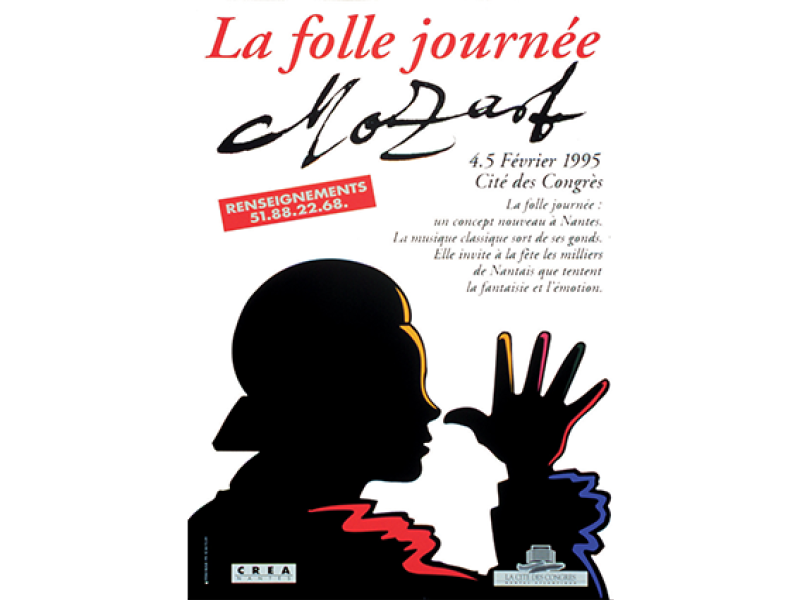 La folle Journée
1995
1e édition
La folle Journée
1995
1e édition
La Folle Journée 1995
MOZART
« Je cherche les notes qui s’aiment. » Wolfgang Amadeus Mozart
Pour cette 1re édition de La Folle Journée, toute la Cité des Congrès de Nantes s’est mise à l’heure viennoise durant deux jours pour fêter l’éternelle jeunesse de Mozart. Ce compositeur, l’un des plus importants de l’histoire de la musique occidentale, a inspiré le concept de ce festival et notamment son nom « La Folle Journée » à travers sa célèbre œuvre Les Noces de Figaro.
Mozart est né à Salzbourg en janvier 1756. Ce grand compositeur de musique classique a embrassé tous les genres musicaux de son époque. Virtuose du clavecin et du violon, il a connu un succès précoce et une carrière fulgurante grâce à son père, qui occupa une place importante dans sa vie. Celui-ci lui enseigna la musique dès son plus jeune âge et organisa son premier concert en public. Le prodige s’est rapidement produit dans de nombreuses villes en Europe et s’est retrouvé très vite sollicité par la noblesse : à Vienne pour l’impératrice Marie-Thérèse, à Versailles pour la famille royale et la cour, à Londres pour le roi Georges III.
Mozart composa plus de 600 œuvres en trente-cinq ans. Celles-ci retranscrivent son génie, sa maîtrise et son originalité. Il a su mener à la perfection le concerto, la symphonie et la sonate, qui devinrent les principales formes de la musique classique et qui firent de lui l’un des plus grands maîtres de l’opéra.